Methods for connecting aluminum and copper wires, how to connect the wires correctly, expert advice. How to properly connect copper and aluminum wire.
Aluminum wiring is still very common these days. It is located mainly in Soviet-built houses, which make up most housing stock of our country. A modern devices and the new electrical wiring already consists of copper conductors. Therefore, whether you like it or not, you often have to connect copper and aluminum wires. They can be connected, but it must be done correctly and efficiently. You can learn how to do this from this article.
Copper and aluminum have different Chemical properties, which affect the quality of their connection. When in contact with copper, aluminum quickly oxidizes under the influence of moisture in the air. Also, these metals have different linear expansion with temperature changes. Because of all this, poor contact is formed at the junction of copper and aluminum and, accordingly, a high contact resistance appears. As a result, heat begins to be released, i.e. the junction of the wires heats up, then the insulation melts and an emergency may occur. This is very bad and you need to do something at home to prevent this from happening.
From the above, we can draw the following conclusions that for a high-quality connection it is necessary to exclude:
- direct contact of copper and aluminum;
- air entering the joint.
There are several connection methods:
- using a bolt with a nut and washers;
- by using screw terminals ZVI;
- using modern universal terminals;
- by twisting through a layer of neutral substance;
- using a "Walnut" type terminal block.
Let's take a closer look at each method of connecting copper and aluminum wires below.
1. Using a bolt with a nut and washers.
This connection method is very simple and accessible to everyone. You will need a bolt, a nut, some washers or, if desired, lock washers. Here we do it like this:
- strip the cores approximately 2 cm;
- we make rings of wires according to the diameter of the bolt;
- We take a bolt, put a washer on it, then a ring of copper conductor, again a washer, a ring of aluminum conductor, a washer and tighten it all with a nut.
- We insulate the entire connection with electrical tape.
See photo instructions:
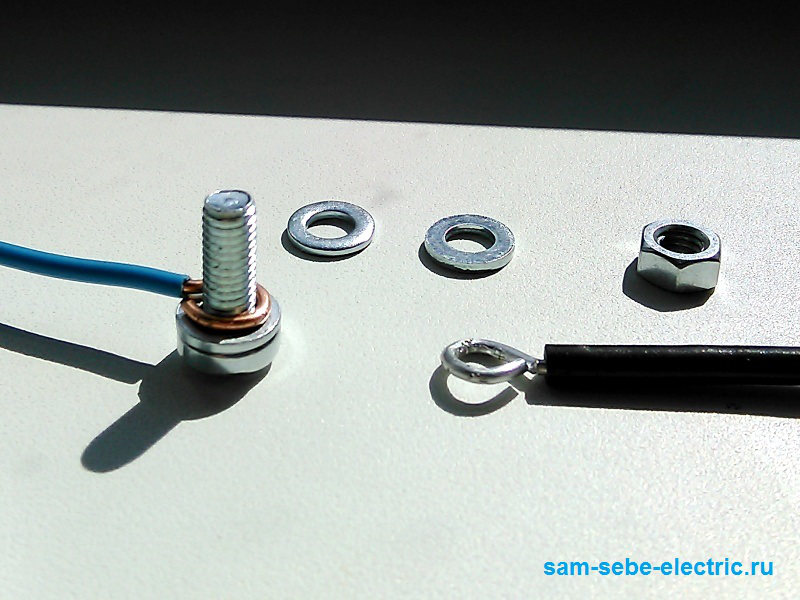
The main thing is not to forget to put an intermediate washer between the copper and aluminum.
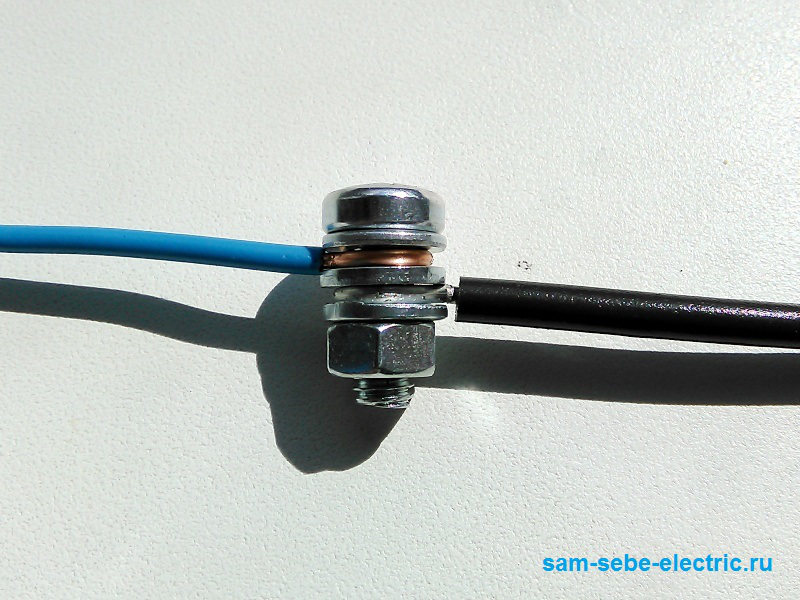
The number of connected cores may vary. It is limited by the length of the bolt. Wires of the same metal can be connected without intermediate washers. It is worth noting that this method is good for monocore (rigid) cables.
The disadvantages of such a connection are its bulkiness, which may not fit everywhere.
Also, very often the existing length of aluminum wires protruding from the junction box is insufficient for this method. Then you have to use other options for connecting wires.
Many people believe bolted connection copper with aluminum wires the most reliable. However, in my practice there was a completely opposite case. See photo below. Here you can clearly see how everything has oxidized and the insulation has completely melted. According to the owner, this connection is only two years old.
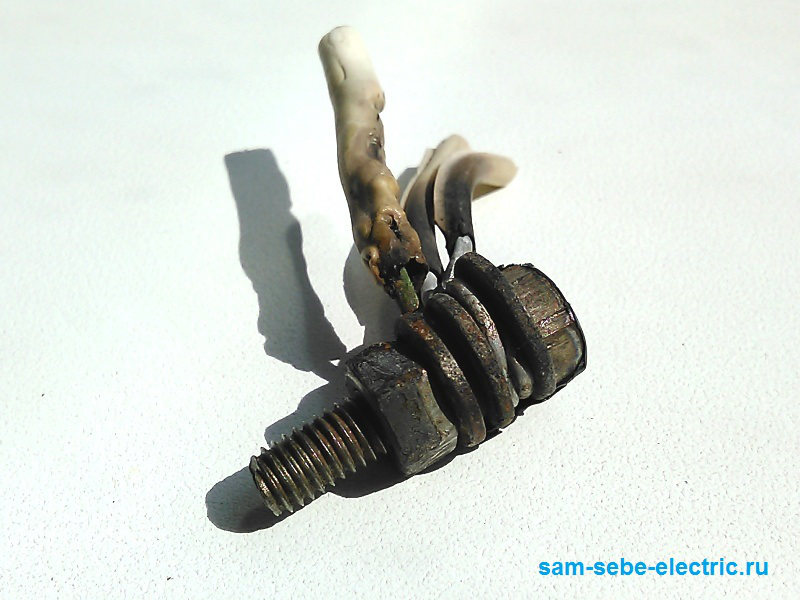
2. Using ZVI screw clamps.
ZVI screw clamps are widely used today. They are used to connect most lamps and chandeliers.
Here we do it like this:
- strip the wires to half the length of the terminal;
- insert them from different sides into the terminal block;
- tighten the bolts.
See photo instructions:

When you insert the wires into the clamp, try to ensure that the copper and aluminum strands do not touch each other.
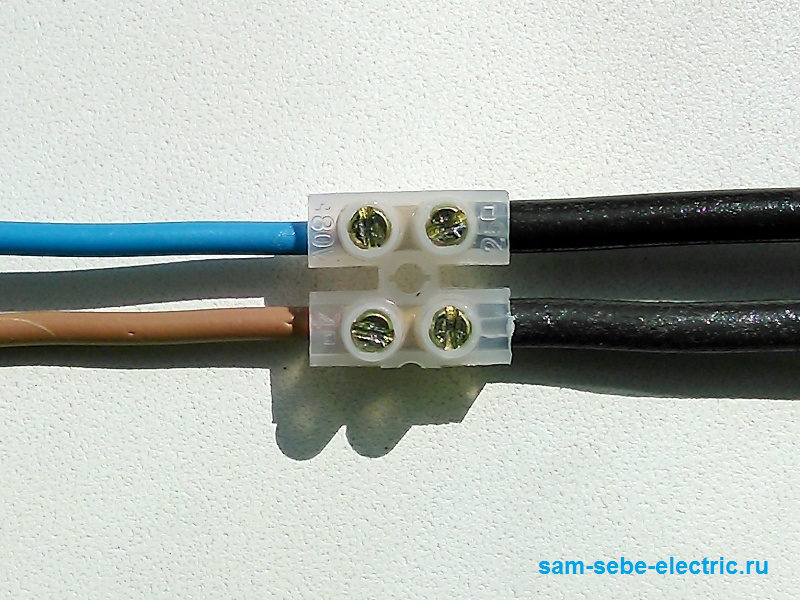
The main thing here is not to overdo it and do not crush the completely aluminum wire with the bolt, as it is very soft. There were cases when you wanted to tighten it harder and more reliably, but in the end it turned out that the core was simply flattened completely and it broke off.
This connection method has a right to life, but personally I don’t really like it.
3. Using modern universal terminals.
These are the popular and highly controversial Wago terminal blocks. Special series are produced with Alu-plus contact paste. This paste prevents the occurrence of electrolytic corrosion at the point of contact between aluminum and copper wires. These terminals can be distinguished by the designation “Al Cu” on the packaging. This includes Wago of the following series:
- 2273-242, 2273-243, 2273-244, 2273-245, 2273-248;
- 773-302, 773, 304, 773-306, 773-308;
- 273-503;
- 224-111, 224-122.
We remove the insulation from the cores to the length indicated on the terminal block itself...

We insert each wire all the way into different sockets (holes). Through the transparent body you can see whether the wire has gone all the way into the terminal.
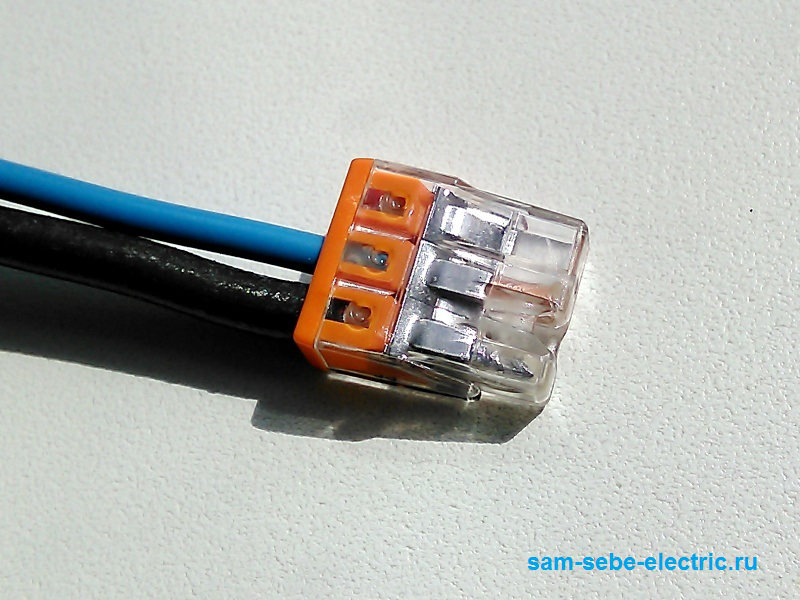
This Wago series is considered one-off. We inserted the wires and if later this connection is not needed, then we simply cut it off. Although if you carefully rotate the wires in different directions, you can pull them out. But some of the special lubricant will also be removed. In the photo below you can see this grease on the wires and you can see its absence in the two holes of the terminal block itself.
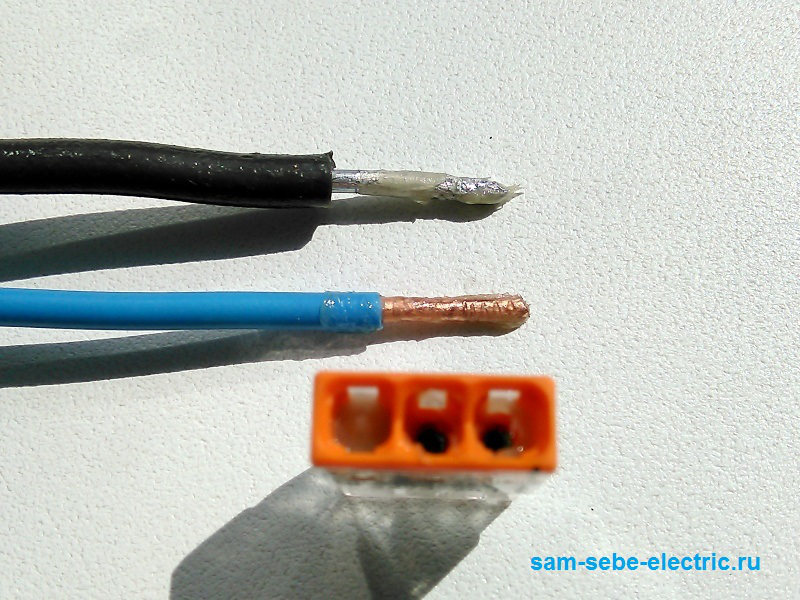
4. By twisting through a layer of neutral substance.
Here the usual twisting of two wires is performed. Only at first copper core must be coated with lead-tin solder. This way we will exclude direct contact of aluminum with copper. Twisting must be done carefully, since the aluminum wire can break even with a slight load. This connection should then be well insulated. An excellent option would be to protect the twist with heat shrink tubing. Personally, I don’t like this option and I didn’t take a photo of this process. Although some people still use this method.
5. Using a "Nut" branch type compression.
About this type I wrote about connecting wires in great detail in the article: Connecting wires using nut-type clamps. There you will find out what sizes these terminal blocks come in, how to choose them correctly and how to use them. Therefore, I will not repeat myself here, but will simply post a small photo instruction.
We disassemble the “nut” and strip the veins to the length of the die...
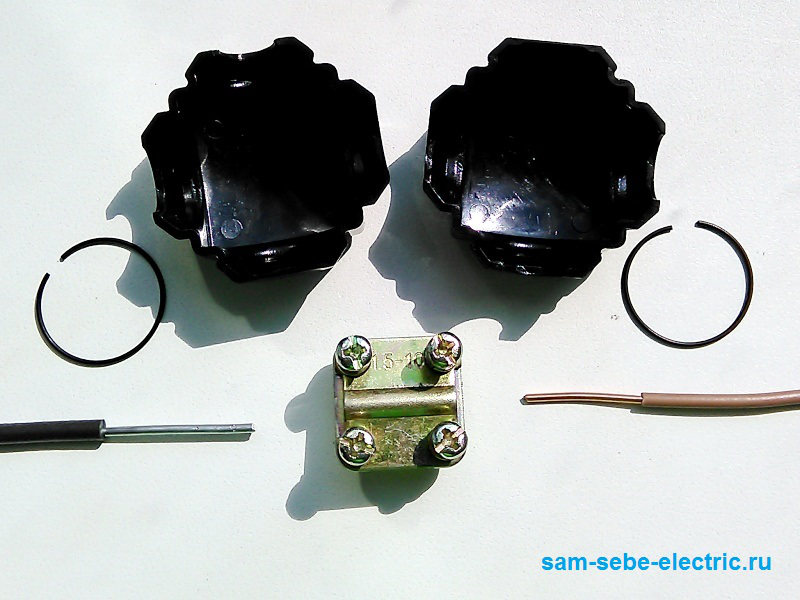
We insert the wires into the die from different sides under special grooves. There must be an intermediate plate between copper and aluminum. It excludes direct contact of these two metals. Then tighten the bolts.
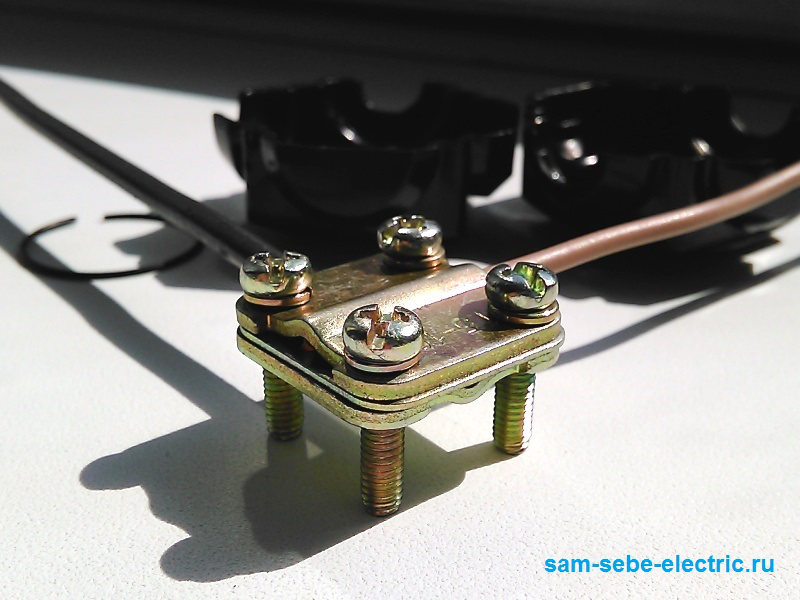
We insert the connection into the dielectric housing...
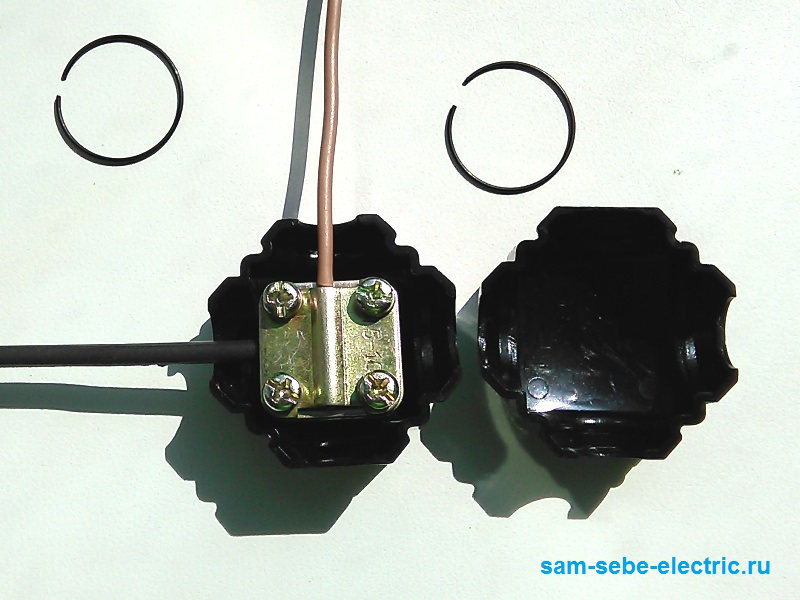
Close the housing and put the retaining rings in place...
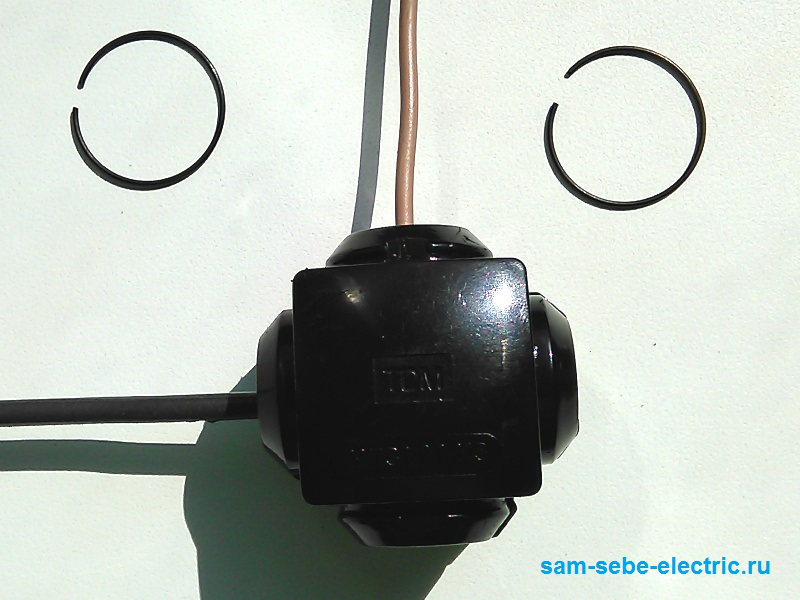
I tried to explain how to connect copper and aluminum wires in simple language. Did I succeed? :-)
How do you connect copper and aluminum wires?
Don't forget to smile:
Electrician judges:
- Why didn’t you rush to save the foreman when he was electrocuted?
- Yes, I didn’t even think that he was being electrocuted. Yelled as usual.
There are still a considerable number of premises where electrical wiring made of aluminum. Wherein modern systems based on the use of copper as a conductor. That is why the problem of joining wires made of these dissimilar materials is relevant. How to connect copper and aluminum wires will be discussed below.
Electrochemical corrosion
You can often come across statements that it is undesirable to combine copper and aluminum into one whole. From the point of view of material compatibility, these are fair statements. What about combining copper and galvanized or steel and silver? There are many options for metal pairs, and it is difficult to remember which ones are compatible with each other and which ones are not. To simplify the task, there are special tables, one of which is presented below.
Table of electrochemical potentials (mV) arising between connected conductors.
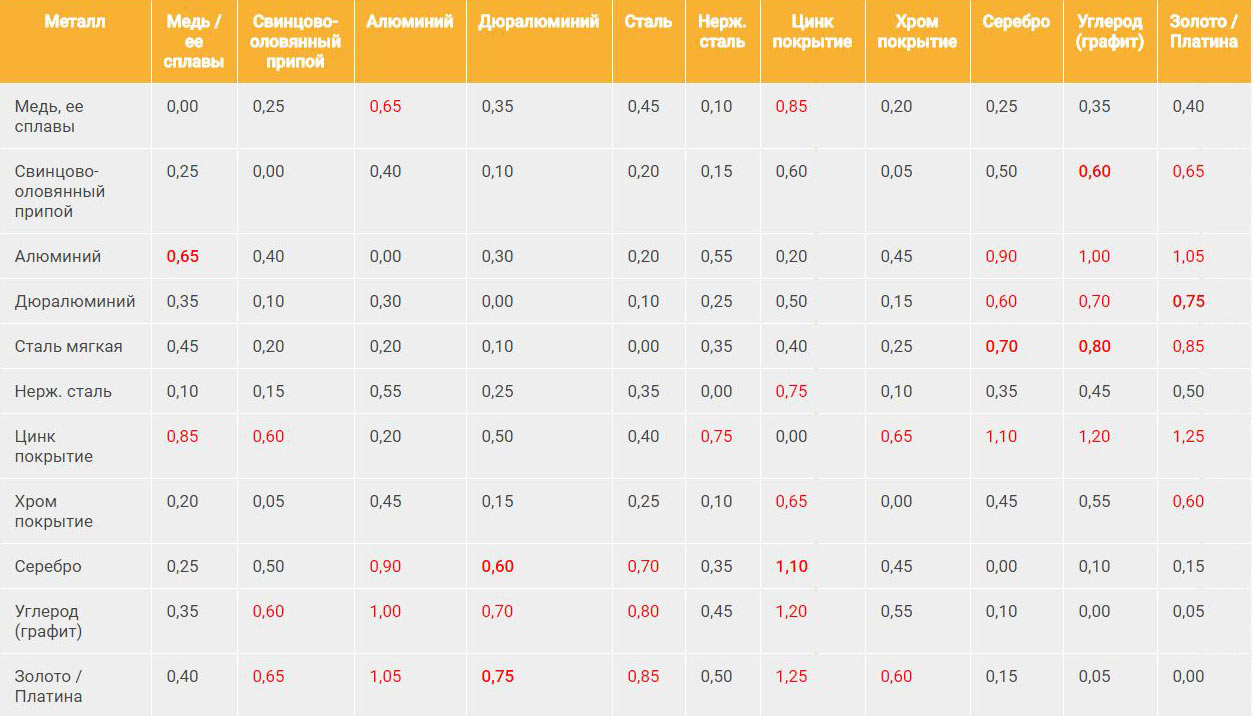
To understand the issue, you need to know what processes occur when different conductors of electricity touch each other. If there is no humidity, the contacts will be reliable in any case. However, in practice, such a situation is impossible, since there is always moisture in the atmosphere, which disrupts the connections.
Every conductor of electricity has some electrochemical potential. This circumstance is used by humans for practical purposes, for example, accumulators and batteries operate on the basis of different potentials.
When moisture gets on contacting metal surfaces, a short-circuited galvanic environment occurs and one of the electrodes is deformed. One of the two metals is destroyed in the same way. Thus, to determine the compatibility of metals, it is necessary to have information about the electrochemical potential of all materials involved in the reaction.
 What happens if copper is combined directly with aluminum?
What happens if copper is combined directly with aluminum? By technical regulations Mechanical joining of metals is permitted if the electrochemical voltage between the two materials is not higher than 0.6 mV. For example, from the table above, it can be established that in the case of joining aluminum and copper, the electrochemical potential is 0.65 mV, which is significantly higher than when joining the same copper with duralumin (0.20 mV).
And, nevertheless, if you really need it, you can also combine materials that are not entirely compatible, such as copper and aluminum. How to connect copper and aluminum wires will be discussed below.
Overview of connection methods
Several methods are used to connect aluminum and copper wires. Moreover, in each of the described cases you will need special devices. Let's consider each type of docking separately.
This type of connection is the most common because it is simple and cheap. If done correctly, a wire connection using nuts and bolts will ensure reliable contact for the entire life of the wiring and electrical appliances. In addition, you can always disassemble the connection, connect additional conductors, etc. Thanks to the threaded connection, the relevance of electrochemical incompatibility of metals is lost, it becomes possible to join aluminum and copper, thick and thin wires, multi-core and single-core. It is important to avoid direct contact between dissimilar materials by making gaskets from spring washers.
To do the job you will need a bolt and nut, as well as a washer (it must be made of anodized steel).
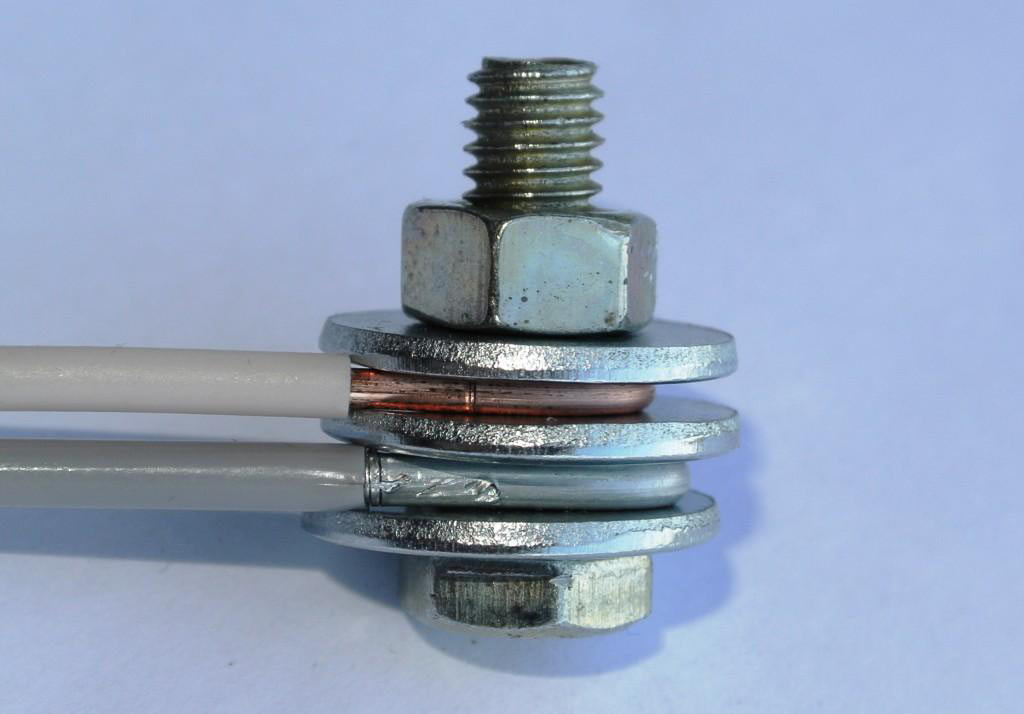
The connection is made as follows:
- We remove the insulating layer from the wires to a short length (about four bolt diameters). We also strip the conductor, especially if its cores have been oxidized. We form rings from the veins.
- First, an aluminum conductor is screwed to the bolt in one girth.
- We put on the puck.
- Now it’s the turn of the copper conductor. We also screw it in one turn.
- Next, screw the nut in such a way as to achieve a reliable connection.
Note! If the docking is carried out for use indoors, where technical specifications There is vibration, for a high-quality result you will need an additional nut.
Terminals
There are several options for terminal connections. One option is the so-called “nuts”. So unusual name terminal blocks are due to their external resemblance to nuts. Several types of “nut” terminals are available.
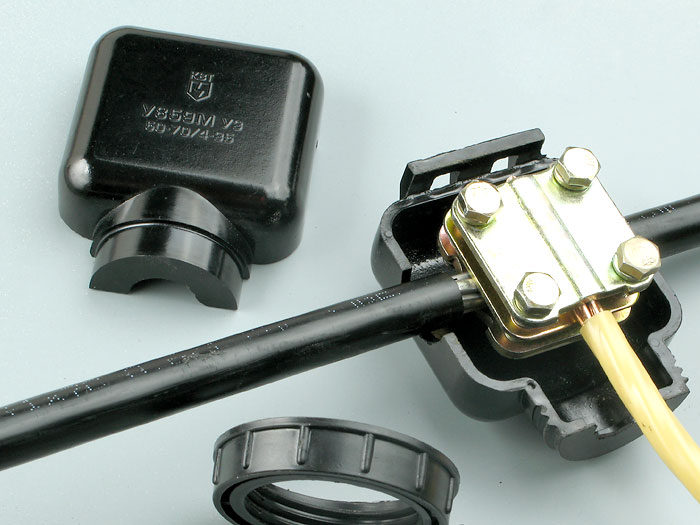
The most primitive model in its design has three demarcation plates inside. The conductors are located between the plates. In this way, direct contact between dissimilar materials is avoided. At the same time, the “nuts” allow you to maintain the supply circuit of the electrical circuit.
To achieve the integrity of the circuit, it is necessary to strip the supply conductor from the insulating layer, unscrew a couple of bolts, install the bare wire between the plates and tighten the bolts again. The insulator must be removed from the outlet ends, and then the wires must be directed into holes located perpendicular to the inlet channel. Next, the conductors are fixed between other delimiting plates.
Available on the market and more complex model, the design of which is designed in such a way that there is no need for cutting conductors. The fact is that the plates of the device contain teeth, which, when squeezed by bolts, simply tear the insulating layer. The described docking option is considered very reliable.
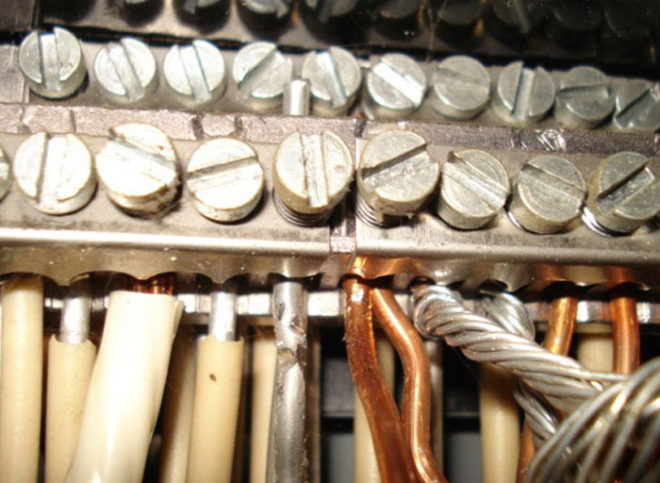
There is another option for terminal blocks - ordinary blocks. The device is a strip with terminals. To connect two dissimilar materials, you need to strip their ends and route the wires into the terminals. The ends are secured with bolts that are located on top of the terminal holes.
Wago terminal blocks
Connecting copper and aluminum wires can be done using Wago terminal blocks. This device belongs to the above-mentioned terminals, however, we should talk about the Wago pads in a little more detail due to their popularity among buyers.
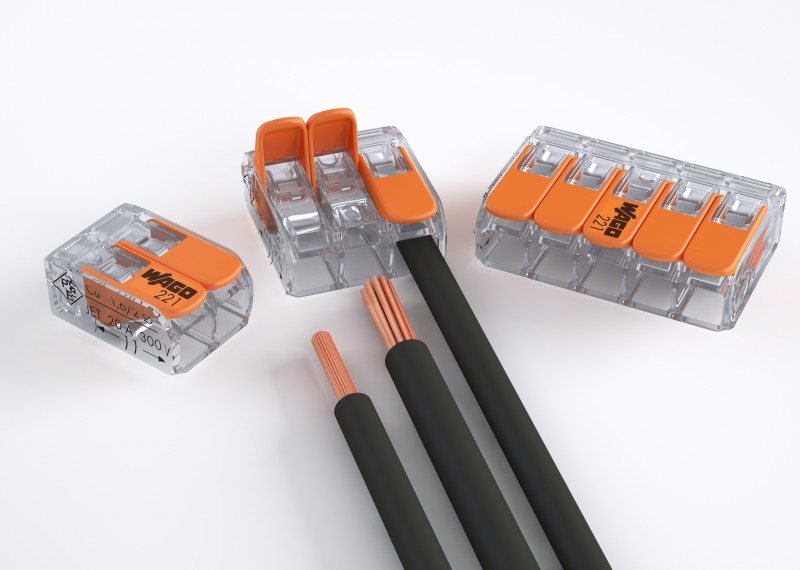
Wago comes in two versions: disposable with a non-removable wire and reusable - with a lever that allows repeated installation and removal of the conductor.
Wago is used for all types of single-core wires whose cross-section is between 1.5 and 2.5 square millimeters. The block can be used in distribution boxes with a current strength of up to 24 amperes. However, in practice it is believed that 10 amperes is more than enough and higher values will lead to overheating.
![]()
To connect the conductors, you need to force one of them into the block hole, as a result of which it will be securely fixed there. To remove the conductor from the hole, you will also need to apply force. It should be borne in mind that as a result of removing the wire from the disposable terminal block, the contact may be deformed, so the next time reliable contact is not guaranteed.
It is much more convenient to use a reusable Wago device. Feature such a terminal block - the presence of an orange lever. Using such a device, you can connect or disconnect all types of wires with a cross-section from 0.08 to 4 square millimeters. The permissible current level is 34 amperes.
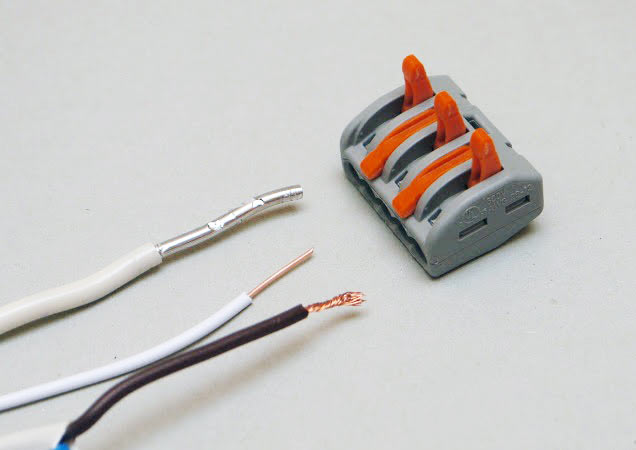
To create a connection, you need to remove 8-12 millimeters of insulation from the wire, lift the lever upward, and direct the wire into the hole in the terminal block. Next, return the lever to the reverse position, thereby fixing the wire in the terminal.
The only one significant drawback Wago - more high price compared to traditional terminals.
Rivets
This method of joining dissimilar conductors resembles a bolted one. However, instead of a nut and bolt, a rivet is used to form a permanent connection. In other words, once fixed, it is no longer possible to remove the rivet without damaging it.
To make the connection, we strip both conductors from insulating material, and also bend the wires into rings. Next, we string one of the rings onto the rivet, after that we put on a steel washer, then we string the ring again, but with the second conductor.
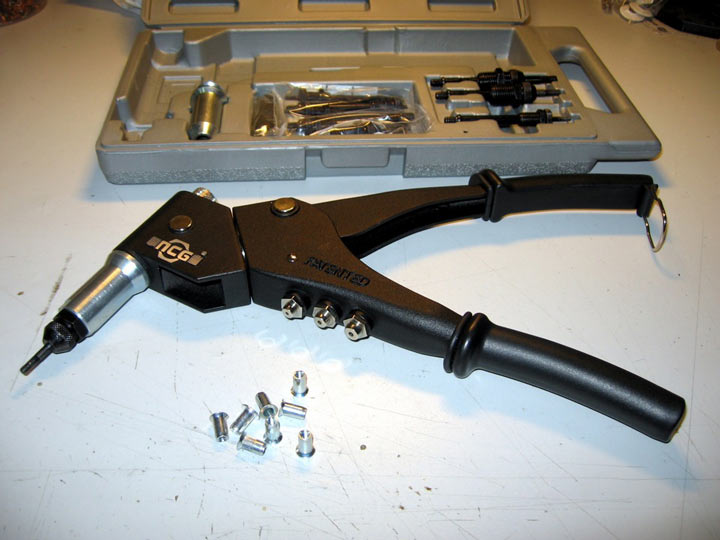
The rivet has a head on one side. Now you need to flatten the second side, thereby forming a second cap, which will act as a fastener. The rivet is deformed either with a hammer or special tool, similar to pliers. The method of joining with rivets allows you to obtain a very high-quality connection.
Soldering iron
If desired, you can solder two dissimilar metals. However, this will require compliance with some technological nuances.
As for copper, there will be no problems with soldering, but with aluminum the situation is more complicated. The fact is that as a result of soldering and under the influence of oxygen on metal surface amalgam appears. This alloy film is incredibly chemically resistant, which is why it does not form adhesion to solder. To remove the film you will need a solution of copper sulfate, a Krona battery and a piece of copper wire.
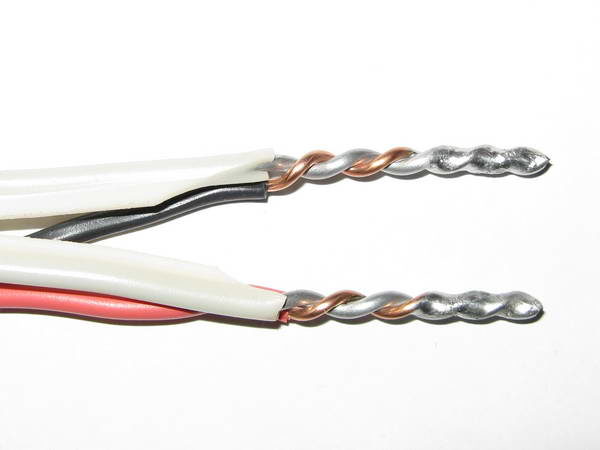
On the aluminum wire, we clean the area for soldering, and after that we apply a little vitriol there. We attach the aluminum wire to the negative pole of the battery, and copper wire We fix one end on the positive pole, and put the other end in copper sulfate. After some time, the aluminum will be covered with a copper layer, onto which a copper conductor can be soldered.
Connection quality
In most of the previously discussed cases, rigid fastening of conductors stripped of the insulating layer is used. However, when joining copper and aluminum, one important technological nuance must be taken into account: aluminum under the influence of load acquires plasticity, as experts say, it begins to “flow”. As a result of this process, the connection weakens, and therefore the bolts need to be tightened regularly. If you do not tighten the bolts in time, the terminal may simply catch fire due to severe overheating.
There are a number of rules that you can follow to achieve a quality connection:
- Conductors with multiple cores should not be clamped too tightly. The wires in such wires are too thin, they easily break under pressure. The consequence of ruptures is an overload on the remaining wires, which can lead to a fire.
- It is important to choose the right terminal taking into account the cross-section of the conductor. If the channel is too narrow, the conductor will not fit, and if it is wide, it will fall out.
- Brass sleeves and terminals are very fragile, so do not clamp them too hard.
- You should pay close attention to the markings, which indicate the maximum possible current strength. Moreover, it is better not to achieve this indicator, limiting yourself to no more than 50% load.
Note! It is not recommended to buy unnamed products made in China. Connectors - too much important detail to save on them. It is best to give preference to products well-known companies(As an example, we can cite the Swiss company ABB).
Stranded wires
As mentioned earlier, conductors with many cores should not be overly pinched. For connection stranded wires most often sleeves or ordinary twists are used. We'll talk about these methods in a little more detail below.
Sleeves
The sleeve is a protective cap made of plastic, under which there is a hollow metal tip. First of all, it is necessary to remove the insulating layer from the conductor. Next, the strands are twisted into one whole, and the resulting “pigtail” is directed into the sleeve. Next, the sleeve is crimped (pliers are suitable for this operation). The tip of the sleeve is inserted into the terminal. To increase the reliability of the connection, the sleeve can be treated with solder.
Twist
Among professional electricians, twisting is not respected. However, there are situations when twisting is the most convenient way way out of the situation (for example, to create a temporary connection or in the absence of the necessary materials).
So, twisting of copper and aluminum is permitted only after thorough cleaning of the aluminum surface. If the copper conductor has many cores, all existing wires must be collected into one “pigtail”. The copper also needs to be coated with solder - this will improve contact.
When twisting, it is important to prevent the wires from breaking. It is best to cover the ends with insulating protective caps, which can be purchased at any hardware store.
Note! Twisting is not allowed in rooms with humid air.
So, in the connection of copper and aluminum conductors there is nothing complicated. You just need to remember the cost of a mistake: incorrectly connected wires can cause not only failure of electrical appliances, but also a fire.
In most new buildings, electrical wiring is initially made of copper wires. This is dictated by the increased load on the network caused by a large number of electrical appliances. In addition, copper is more durable, does not oxidize and has best performance electrical conductivity.
But in old houses, aluminum wiring is installed everywhere. Many people planning major renovation, replace aluminum wires with copper. However, not everyone has such an opportunity. In addition, sometimes replacement is not possible due to technical reasons.
What you should know
In these cases, it is necessary to connect aluminum and copper conductors to each other. But such a connection by simple twisting is prohibited: electrochemical corrosion begins between the wires caused by natural humidity, such contact is quickly destroyed. It is best to connect wires of the same material.
But the connection of copper and aluminum conductors is quite common. For this you can use various ways, which have proven themselves in practice. The most commonly used options for making such a connection are presented below.
Methods for reliably connecting different wires
There are several ways to connect aluminum and copper in electrical wiring. The main objective of all these methods is to ensure the reliability and durability of the contact, while minimizing the possibility of electrochemical corrosion.
Screw connection
The screw method of connecting aluminum and copper conductors is simple, yet reliable and durable. This option can be used if you need to connect wires of different or large section. The essence and technology of this method is as follows:
- The ends of both wires are cleared of insulation (approximately 30 mm);
- Using pliers, the ends are bent into a circle.
Then the bolt is taken suitable size and diameter. The structure is assembled in the following order:
- A regular washer is put on the bolt;
- Circumference of the first conductor;
- Again the puck;
- Second wire ring;
- Another puck;
- The structure is clamped with a nut;
One of the advantages of this method is the ability to connect more than two wires. The maximum number of clamped cores is limited only by the length of the bolt.
When making such a connection, do not forget to place washers between the wires: do not allow the copper to come into contact with the aluminum conductors.
Twisting wires
This method is also widely used in practice, but requires a special approach. To twist copper and aluminum conductors was durable, and corrosion did not form between them, it is better to do the following:
- The cores are stripped of insulation (at least 4 cm);
- Copper wire must be tinned using tin solder;
- After this, the current-carrying wires are twisted together in the usual way;
- To increase the protection of such a connection from moisture, it can be treated with a special heat-resistant varnish;
- After the varnish has dried, the twist is securely insulated and ready for use.
The twisting must be done in such a way that the strands are twisted together. Twisting one wire around another is unacceptable!
Terminal blocks
The use of screw blocks is very popular and widely used in practice. This method has proven itself best in electrical panels where there is a need for connection large quantities wires The pads are also used in distribution boxes, providing removable contacts, which facilitates inspection and repair if necessary.
Let's consider the order of work when choosing this method to connect copper and aluminum:
- As usual, the ends of the wires need to be stripped. The insulation is removed by approximately 0.5–1 cm;
- After this, the stripped ends are inserted into the terminals and clamped with screws with medium force so as not to break the wires.
Advice! Before clamping single-core wires with screws, it is better to flatten them a little with a hammer or pliers. This is necessary to increase the contact area.
This method is applicable to both black plastic terminal blocks and thinner insulated black plastic terminals. white plastic. When asked which terminal block is better, there is an opinion that white terminal blocks are less reliable (in mechanical design). Therefore, they are often used as an adapter for connecting lamps, chandeliers and other low-power consumers.
Separately, we note that it is possible to hide the terminals under the plaster only if they are enclosed in a junction box.
WAGO clamps and terminal blocks
More modern version pads equipped with a clamp German manufacturer WAGO. These terminals are available in two types:
- One-piece pads have a cast, often transparent body. To fix the wires, just insert the cleaned ends of the wires into such a cap, the clamp will securely fix them. The disadvantage of this method is that it is disposable: to redo the connections, you will need to bite off the old clamps;
- Detachable terminal blocks do not have this drawback. A special lever makes it easy to fix the wires, and if necessary, disassemble the connection; just lift it up, the clamps will open and the ends will come out of the terminal.
Using such clamps, you can make a multi-core (from 2 to 8) connection, and also use the terminal block as an adapter for a branch in electrical wiring. Another advantage of this method of connecting copper and aluminum is that there is no need for additional contact insulation. The WAGO pad body is completely insulated and reliable.
Permanent connections
Finally, let's look at another way to connect copper to aluminum wires. To do this you will need a special rivet tool. Now such devices are widely popular, and many craftsmen already have them.
The technology of this method is similar to the method using a bolt and nut. Let's look at how, using a rivet tool, you can make a reliable connection of electrical wires:
- Having stripped the conductors of insulation, the ends are folded into a small ring using round pliers. It is important that the diameter is as small as possible so that the rivet does not dangle too loosely;
- Then the structure is assembled in the same order as with the screw method: copper and aluminum conductors are put on the stud, a small washer is used as a gasket;
- After this, the rivet rod is placed in the head of the device, the handles of which are compressed until it clicks. The connection is ready!
The disadvantage of this method is the inability to disassemble the structure. If you need to connect another wire, the rivet will have to be cut out and the connection made again. Also, we should not forget about the importance of insulating this area: you can use cambrics or insulating tape.
Let's sum it up
We have studied the most common and used cores from various materials: copper and aluminum. They are reliable, provide long-lasting contact and eliminate oxidation which leads to electrochemical corrosion.
Connecting wires made of dissimilar metals (a particular and most common case is copper and aluminum) is most often necessary in cases where the home wiring is made of copper conductor, and the entry into the house is made of aluminum.
It happens the other way around. The main thing here is the contact of dissimilar metals. Copper and aluminum cannot be combined directly.
The reasons lie in the electrochemical properties of metals. Most metals, when combined with each other in the presence of an electrolyte (water is a universal electrolyte), form something like a regular battery. For different metals, the potential difference upon contact is different.
For copper and aluminum this difference is 0.65 mV. It is established by the standard that the maximum permissible difference should be no more than 0.6 mV.
If there is a higher potential, the conductor material begins to deteriorate and become covered with oxide films. The contact will soon lose reliability.
For example, the electrochemical potential difference of some other pairs of metals is:
- copper - lead-tin solder 25 mV;
- aluminum - lead-tin solder 40 mV;
- copper – steel 40 mV;
- aluminum – steel 20 mV;
- copper – zinc 85 mV;
Twisting wires

The simplest, but least reliable way to connect conductors. As mentioned above, you cannot directly twist copper and aluminum wires. The only one possible variant contact of such materials - tinning one of the conductors with lead-tin solder.
It is very difficult to tin the aluminum at home, but there will be no problems with copper. A powerful piece of solder and a little rosin or other flux for soldering copper and copper alloys is enough. Tinned copper and pure aluminum conductors are tightly twisted together using pliers or pliers so that the wires wrap tightly and evenly around each other.
It is unacceptable for one conductor to be straight and the other to wrap around it. The number of turns should be at least 3-5. The thicker the conductors, the fewer the number of turns you can make. For reliability, the twisted area can be wrapped with a bandage made of thinner tinned copper wire and additionally soldered. The twisting area must be carefully insulated.
Threaded connection
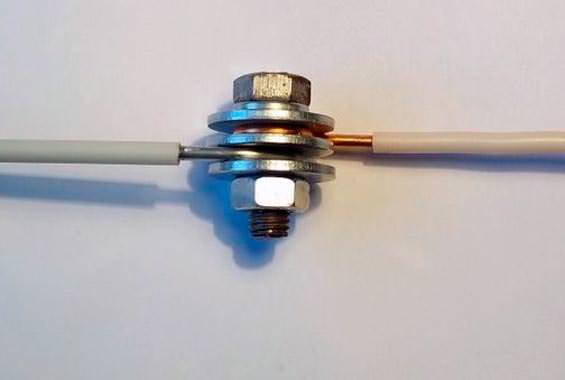
The most reliable connection of wires is threaded (bolted). The conductors are pressed against each other using a bolt and nut. To make such a connection, it is necessary to make rings with internal diameter, equal to the diameter of the bolt.
Just like for twisting, the copper core must be tinned. Must be serviced stranded wire(even if wires of the same metal are connected).
The resulting compound looks like a sandwich:
- bolt head;
- washer (with an outer diameter no less than the diameter of the ring on the wire);
- one of the connected wires;
- second wire;
- washer similar to the first one;
- screw;
The copper core does not need to be tinned, but in this case a steel washer must be placed between the conductors.
A significant disadvantage of this method is its large dimensions and, as a consequence, difficulties with insulation.
Terminal blocks
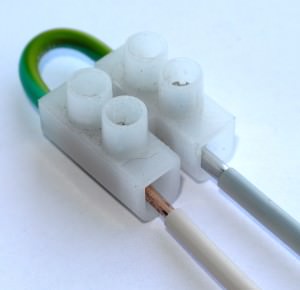 The most technologically advanced way to connect wires is to use special terminal blocks.
The most technologically advanced way to connect wires is to use special terminal blocks.

And finally, a few tips that you should take into account in order to protect yourself in the future and not redo the work:
- For stripping conductors You should not use side cutters, pliers or other tools with a similar operating principle. In order to cut the insulation without affecting the body of the wire, considerable experience is required and still in most cases the integrity of the wire will be compromised. Aluminum is a soft metal, but it does not tolerate bending very well, especially if the integrity of the surface is damaged. It is possible that the wire may break during installation. And it’s much worse if this happens a little later. It is necessary to remove the insulation sharp knife, moving it along the conductor, like stripping a pencil. Even if the tip of a knife removes some layer of metal, a scratch along the wire is not terrible.
- For tinning copper conductors Under no circumstances should you use acid-containing fluxes (zinc chloride, etched hydrochloric acid and so on). Even thorough cleaning connection will not save it from destruction for some time.
- Stranded conductors Before installation, it is necessary to irradiate it to obtain a monolithic conductor. The only exceptions are spring clamps and terminal blocks with pressure plates.
- Washers, nuts and bolts for detachable or permanent connections should not be made of galvanized metal. The potential difference between copper and zinc is 0.85 mV, which is significantly greater than the difference when copper and aluminum are directly connected.
- For the same reason, you should not purchase overly cheap terminal blocks. unknown manufacturer. Practice shows that metal elements These pads are often zinc coated.
- You can't use advice protect the direct connection of copper and aluminum conductors with various water-repellent coatings (grease, paraffin). Machine oil is difficult to remove from leather alone. Sun, air, negative temperatures will destroy protective covering much faster than we would like. In addition, some lubricants (especially grease oil) initially contain up to 3% water.
1. If a permanent magnet is pushed into a coil and a electricity, then this phenomenon is called:
A. Electrostatic induction B. Magnetic induction
B. Inductance D. Electromagnetic induction
D. Self-induction
2. Inductance in the SI system has the dimension:
A. B. Tl C. Gn D. Wb D. F
3. Flux of magnetic induction through a surface of area S determined by the formula:
A. B.S. B. BSsos IN. G. BStg D.
4. The rate of change of magnetic flux through the circuit determines:
A. Loop inductance B. Magnetic induction
B. Induction emf D. Self-induction emf
D. Electrical resistance contour
5. The magnetic flux through a loop with an area of 10 cm2 is 40 mWb. The angle between the induction vectors and the normal is 60. Induction module magnetic field equal to:
A. 2∙10-5 T B. 8∙105 T C. 80 T D. 8 T E. 20 T
6. When moving permanent magnet the galvanometer needle is deflected into the coil. If the speed of the magnet is increased, then the angle of deflection of the needle:
A. Will decrease B. Increase C. Reverse
D. Will not change D. Will become equal to zero
7. When the current in the coil decreases by 2 times, the energy of its magnetic field:
A. Will decrease by 2 times B. Will increase by 2 times
B. Will decrease by 4 times D. Will increase by 4 times
D. Will not change
8. August 29, 1831 The phenomenon of electromagnetic induction was discovered:
A. Oersted H. B. Lentz E. V. Amper A.
G. Faraday M. D. Maxwell D.
9. If at a current of 3 A a magnetic flux of 600 mWb appears in the frame, then the inductance of the frame is equal to:
A. 200 Gn B. 5 Gn C. 0.2 Gn D. 5∙10-3 Gn D. 1.8 Gn
10. The self-induction emf that occurs in a coil with an inductance of 0.2 H when the current changes uniformly from 5 A to 1 A in 2 s is equal to:
A. 1.6 V B. 0.4 V C. 10 V D. 1 V. D. 2.5 V
11. In a coil made of aluminum wire (=0.028 Ohm∙mm2/m) with a length of 10 cm and a cross-sectional area of 1.4 mm2, the rate of change of the magnetic flux is 10 mWb/s. The strength of the induction current is equal to:
A. 50 A B. 2.5 A C. 10 A D. 5 A D. 0.2 A
12. A straight conductor with a length of 1.4 and a resistance of 2 Ohms, located in a uniform magnetic field with an induction of 0.25 T, is acted upon by a force of 2.1 N. The voltage at the ends of the conductor is 24 V, the angle between the conductor and the direction of the induction vector is equal to:
A. 0 B. 30 C. 60 D. 45 D. 90
13. In a coil having 1000 turns, with a uniform disappearance of the magnetic field for 0.1 s, an emf equal to 10 V is induced. The flux permeating each turn of the coil is equal to:
A. 10 Wb B. 1 Wb C. 0.1 Wb D. 10-2 Wb D. 10-3 Wb
14. A coil in the form of a solenoid with a cross section of 10 cm2 is placed in a uniform magnetic field, the induction of which varies with time, as shown in the graph. The magnetic induction vector is parallel to the axis of the coil. How many turns does the coil have if at the moment of time t=3 with an induced emf of 0.01 V acting in it?
A. 20 B. 50 C. 100 D. 200 D. 150
15. Coil diameter d, having N turns, is in a magnetic field directed parallel to the axis of the coil. What is the average value of the induced emf in the coil if the magnetic field induction over time t increased from 0 to B?
A B C D E.
16. If, with a uniform decrease in current strength by 0.2 A in 0.04 s, a self-inductive emf equal to 10 V appears in the coil, then the inductance of the coil is ...
Palamedea / June 24, 2014, 11:48:29 pm
1. A current of 1 A flows through a conductor for a year. Find the mass of electrons passing through the cross section during this period of timeconductor. Ratio of electron charge to its mass e/te= 1.76 • 10^11 C/kg.
2.In a conductor with a cross-sectional area of 1 mm2, the current is 1.6 A. The electron concentration in the conductor is 1023 m~3 at a temperature of 20 °C. Find the average speed of directional motion of electrons and compare it with the thermal speed of electrons.
3. Over 4 s, the current strength in the conductor linearly increased from 1 to 5 A. Plot a graph of the current strength versus time. How much charge passed through the cross section of the conductor during this time?
Fredledikaskelinjj / Oct 28 2014, 2:41:35
Determine the resistance of an aluminum wire 150 cm long if its cross-sectional area is 0.1 mm2. What is the voltage at the ends of this wire,if the current in it is 0.5 A?




